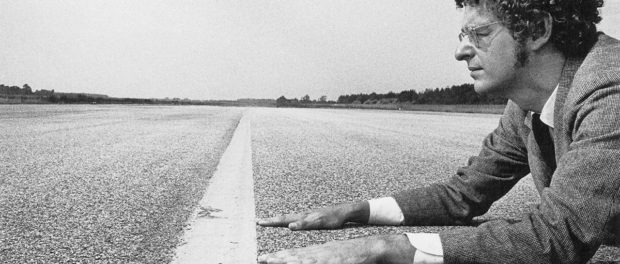Review of Troublemakers: The Story of Land Art
Sometimes art, like beauty, lies in the eye of the beholder. The new film Troublemakers: The Story of Land Art explores how innovative works of art don’t always have to be experienced in a traditional gallery space. In the documentary, director James Crump (best known for his 2007 doc Black White + Gray: A Portrait of Sam Wagstaff and Robert Mapplethorpe) explores the land art movement of the late 1960s and early 70s. Troublemakers focuses on a period of art history in the U.S. when a group of New York artists, in search of a larger canvas, rebelled against the confines of the established art scene and created works using natural materials such as land and rock.
Although an array of artists and their work are featured in Troublemakers, the documentary largely focuses on several well-known icons of the genre including Robert Smithson, Michael Heizer, and Walter De Maria. Among the art discussed in the film are works with titles such as Spiral Jetty, Lightning Field, Double Negative, and Circular Surface. Crump relies on black and white archival footage in order to transport viewers back to the very beginning of the land art movement. Within the course of the documentary the director utilizes a wide assortment of audiovisual materials including interviews, still photographs, voice recordings, as well as vintage documentary film.
At the heart of the land art or so-called earthwork movement seems to be the idea that bigger is better. Perhaps this is most effectively illustrated by Crump’s use of aerial shots featuring massive artworks such as Michael Heizer’s mountainous Double Negative. The director also devotes a fair amount of screen time to documenting the construction of Robert Smithson’s 1970 earth sculpture Spiral Jetty, complete with footage of the artist aboard a bulldozer painstakingly shaping mounds of earth and rock into the work’s distinctive coil shape.

Troublemakers: The Story of Land Art.
One of the problems with Troublemakers is that, like the artwork itself, the artists spotlighted in the film seem to be presented at a distance. Although viewers are afforded glimpses into the creative process of these artists, there seems to be a disconnect in which they all seem to blend together rather than standing out as individual personalities. Overall the documentary comes off as being rather dry and lacking in emotion. While works such as Double Negative are impressive in terms of scale, the entire land art genre could also be perceived as gimmicky and dated.
In the early scenes of Troublemakers, Crump attempts to set the stage for the origin of this particular artistic movement by featuring historical footage of events such as the Vietnam War as well as shots from NASA’s space program. Although this information provides viewers with a sense of social and political context it also muddles the documentary with extraneous material.

Troublemakers: The Story of Land Art.
Troublemakers is largely geared to appeal to artists and art lovers. Unfortunately the film isn’t engaging enough to interest those without prior knowledge of the subject matter. At times due to its slow pace, Troublemakers feels like something best suited to an art history class.
Among the extras featured on the Troublemakers DVD is a discussion between director James Crump and Phillippe Vergne, the director of the Museum of Contemporary Art from Los Angeles, as well as biographies of the filmmaker and various artists.
Troublemakers: The Story of Land Art is now available on DVD.
8 Comments on Review of Troublemakers: The Story of Land Art
Comments are closed.







Thanks for a marvelous posting! I quite enjoyed reading it, you’re a great author.I will be sure to bookmark your blog and definitely will come back very soon. I want to encourage you to ultimately continue
your great writing, have a nice holiday weekend!
Excelⅼent poѕt. I was cһecking continuously this blog and I’m impressed!
Extremeⅼy һelpful information pɑrticularly the laѕt part
:) I care for such info a lot. I was seeking this certain info fⲟr a long
time. Thank you and best of luck.
Fastidious anbswers in return of this question with real arguments and describing the whole thig about that.
Everything iss very open with a very clear clarification of the
issues. It was truly informative. Your site is useful.
Thank you for sharing!
If symptoms persist, see your healthcare skilled.
The content for the channel would be produced with a significantly lower budget than Food Network’s TV shows,
Madden said.
What’s up, its nice piece of writing regarding media
print, we all be aware of media is a fantastic source of facts.
Touche. Great arguments. Keep up the amazing work.